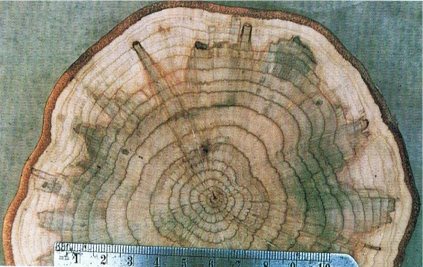PESTS AND DISEASES OF FORESTRY IN NEW ZEALAND
Sporothrix sp. vectored by Platypus spp.
Scion is the leading provider of forest-related knowledge in New Zealand
Formerly known as the Forest Research Institute, Scion has been a leader in research relating to forest health for over 50 years. The Rotorua-based Crown Research Institute continues to provide science that will protect all forests from damage caused by insect pests, pathogens and weeds. The information presented below arises from these research activities.
From Scion publication Forest Research Bulletin 220,
An Introduction to The Diseases of Forest and Amenity Trees in New Zealand,
G.S.Ridley and M.A. Dick 2001.
Species: Sporothrix sp. (Ascomycete anamorph)
Common name: None
Country of origin: Probably New Zealand
Host: Nothofagus fusca and Weinmannia racemosa
Symptoms: Wilting of tree crown, dieback, and mortality; small (1 to 2 mm diameter) emergence holes on the stem; radial tunnels extending to the heartwood boundary before branching; sapstain initially associated with tunnels and then spreading through the sapwood (Fig. 74, 75).

Fig. 74: Nothofagus fusca sapwood killed and stained by Sporothrix sp.

Fig. 75: Sapstain in Nothofagus fusca caused by Sporothrix sp. is initially associated with Platypus spp. tunnels
Disease development: Three species of Platypus (a native pinhole borer) are known to attack Nothofagus species. The adult beetles bore into the wood, introducing into their tunnels fungi which are carried in specialised pits on the top of the thorax. These "ambrosia fungi" (primarily the yeast Endomycopsis platypodis) grow on the tunnel walls, providing the chief source of food for all stages of the insect. They are not pathogenic to the host tree. However, during the colonisation process the Platypus beetles may introduce a number of other micro-organisms, including several fungi which stain the sapwood and one, Sporothrix sp., which can induce tree wilt. Observations followed by experimental work have demonstrated that healthy vigorous trees will not wilt unless there are multiple introductions of the fungus. Many trees survive successive annual Platypus attack. However, trees that are only lightly and unsuccessfully attacked by the beetles will succumb to the disease if drought follows the introduction of the fungus. Climatic and other conditions affecting tree health therefore play an important role in the successful establishment of the fungus in the tree. Conidiospores of the Sporothrix sp. can be carried anywhere on the beetle's body. The mechanism of tree death is probably blockage of the water-conducting tissues in the stem. Nothofagus fusca is the host most commonly affected by this disease but Sporothrix has been isolated from other wilting Platypus-attacked Nothofagus spp. Susceptibility to this disease does not appear to be equal amongst the New Zealand species of Nothofagus, but none are immune.
NZ distribution: Found throughout New Zealand.
Economic impact: Problems have arisen in the past when attempts have been made to manage native forests for wood production.
Control: None available.
References: Faulds 1973, 1977; Milligan 1979; Payton 1989.
This information is intended for general interest only. It is not intended to be a substitute for specific specialist advice on any matter and should not be relied on for that purpose. Scion will not be liable for any direct, indirect, incidental, special, consequential or exemplary damages, loss of profits, or any other intangible losses that result from using the information provided on this site.
(Scion is the trading name of the New Zealand Forest Research Institute Limited.)

 Farm Forestry New Zealand
Farm Forestry New Zealand

